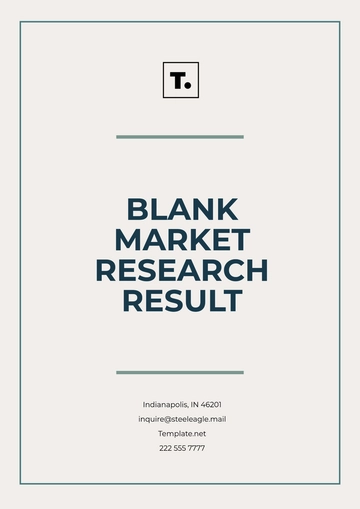Free Industry Benchmarking Market Research

Company: [YOUR COMPANY NAME]
Written By: [YOUR NAME]
I. Executive Summary
The global industry landscape in 2060 presents significant opportunities and challenges. This report provides a comprehensive analysis of industry benchmarks, highlighting key performance metrics, trends, and best practices. The research aims to equip stakeholders with actionable insights to drive strategic decision-making and improve competitive positioning.
II. Introduction
Industry benchmarking is a critical tool for evaluating performance against peers and identifying areas for improvement. This research focuses on the benchmarking of key industry players in the tech sector, examining financial performance, operational efficiency, and customer satisfaction metrics.
III. Industry Overview
A. Market Size and Growth
The global tech industry is projected to reach a valuation of USD 15 trillion by 2065, with an annual growth rate of 6.5%. The sector is characterized by rapid technological advancements and increasing demand for innovative solutions.
B. Key Trends
Artificial Intelligence Integration: AI continues to transform business processes, enhancing efficiency and customer experience.
Sustainability Initiatives: Companies are increasingly adopting sustainable practices to meet regulatory requirements and consumer expectations.
Digital Transformation: The shift towards digital business models remains a top priority for organizations aiming to stay competitive.
C. Regulatory Environment
The industry is subject to stringent regulations regarding data privacy, cybersecurity, and environmental impact. Compliance with these regulations is crucial for maintaining operational viability and brand reputation.
IV. Methodology
This research employs a mixed-methods approach, combining qualitative and quantitative data collection methods. Primary data was obtained through surveys and interviews with industry experts, while secondary data was gathered from reputable sources, including industry reports and financial statements.
V. Key Findings
A. Financial Performance
The analysis reveals that companies with higher investment in R&D exhibit superior financial performance. On average, R&D investment accounts for 12% of total revenue among top performers.
B. Operational Efficiency
Efficient supply chain management and automation are critical drivers of operational efficiency. Companies utilizing advanced analytics report a 15% reduction in operational costs.
C. Customer Satisfaction
Customer-centric organizations that prioritize personalization and seamless experiences achieve higher satisfaction scores. The average Net Promoter Score (NPS) among leading companies is 72.
VI. Competitive Analysis
A. Market Leaders
Tech Innovators Inc.
Market Share: 18%
Revenue (2060): USD 300 billion
Future Solutions Ltd.
Market Share: 15%
Revenue (2060): USD 250 billion
Visionary Technologies
Market Share: 12%
Revenue (2060): USD 200 billion
B. SWOT Analysis
Company | Strengths | Weaknesses | Opportunities | Threats |
|---|---|---|---|---|
Tech Innovators Inc. | Strong R&D capabilities | High operational costs | Expansion into emerging markets | Regulatory compliance |
Future Solutions Ltd. | Robust supply chain | Limited brand presence | Strategic partnerships | Intense competition |
Visionary Technologies | Advanced AI solutions | Reliance on key markets | Innovation in product offerings | Cybersecurity threats |
VII. Benchmarking Data and Analysis
A. Performance Metrics
The following table highlights key performance metrics for benchmarking:
Metric | Industry Average | Top Performers | Bottom Performers | Improvement Potential |
|---|---|---|---|---|
Revenue Growth (%) | 6.5 | 10.2 | 3.1 | 4.0 |
Operating Margin (%) | 18.0 | 25.0 | 10.5 | 8.0 |
Customer Satisfaction (%) | 78 | 90 | 65 | 12 |
R&D Investment (%) | 10 | 15 | 5 | 10 |
Employee Turnover (%) | 12 | 8 | 20 | 5 |
B. Graphical Representation
Chart: Revenue Growth Comparison (2060)
VIII. Conclusions and Recommendations
A. Strategic Insights
Invest in Innovation: Companies should increase investment in R&D to drive innovation and maintain competitive advantage.
Enhance Operational Efficiency: Leveraging automation and advanced analytics can significantly reduce costs and improve efficiency.
Focus on Customer Experience: Prioritizing customer satisfaction through personalized experiences can lead to increased loyalty and market share.
B. Future Outlook
The industry is poised for continued growth, driven by technological advancements and increasing demand for innovative solutions. Companies that adapt to changing market dynamics and prioritize strategic investments will be well-positioned for success.
C. References
Gartner. (2059). Tech Industry Outlook 2060. Retrieved from Gartner website.
McKinsey & Company. (2059). The Future of Tech: Growth, Trends, and Strategies. Retrieved from McKinsey website.
International Data Corporation (IDC). (2060). Global Tech Industry Report. Retrieved from IDC website.
- 100% Customizable, free editor
- Access 1 Million+ Templates, photo’s & graphics
- Download or share as a template
- Click and replace photos, graphics, text, backgrounds
- Resize, crop, AI write & more
- Access advanced editor
Elevate your competitive analysis with Template.net’s Industry Benchmarking Market Research Template. This customizable template, editable in our AI Editor Tool, allows you to assess industry standards, identify key performance indicators, and compare your business with competitors. Ideal for strategists and business analysts, this tool ensures you stay ahead in the market.





























